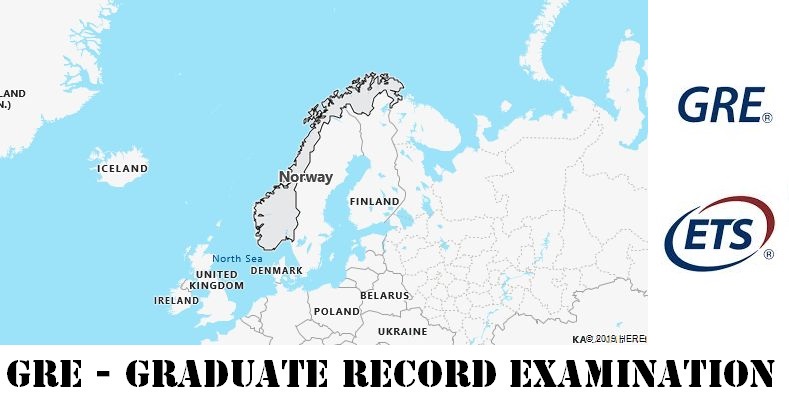GRE Testing Locations
Decided to take GRE exam? Now it is time to determine where to take the test. This site provides a full list of GRE testing centers in Norway, among which, you can choose one that is nearest to you. Good news is that the following GRE test locations in Norway offer both GRE general test and the GRE subject tests.

- ANSA – STN20164A
Storgata 19, 5th floor, Telephone No. 1: (+47) 22 47 76 00, Oslo
Norway 0184
Computer Based Test
GRE Test Dates
There are two types of test format offered by the test maker – ETS: Computer-delivered and Paper-delivered GRE general tests. For computer based test format, the GRE General Test is offered year-round on a continuous basis, and available for registration on a first-come, first-served basis. For paper based general test, testing is available three times per year. The following test dates apply:
| Test Dates for Paper Based | Deadlines for Registration | Scores Available |
|---|---|---|
| November 09, 2019 | October 4, 2019 | December 20, 2019 |
| February 1, 2020 | December 27, 2019 | March 13, 2020 |
GRE Subject Tests in Norway
The GRE Subject Tests are available on paper based only. In all GRE test centers throughout the world (both inside and outside United States), the exam is available three times a year. The three test dates are:
- April
- September
- October

More about Norway
Geography
Norway is located in the west of the Scandinavian Peninsula (Scandinavia). It borders in the south on the North Sea, in the west on the European Arctic Ocean and in the north on the Arctic Ocean, in the northeast on Russia and Finland and in the east on Sweden. Norway also includes the islands of Spitzbergen and Jan Mayen. If the up to 200 km long fjords (e.g. Hardanger, Sogne, Nord, Romsdalsfjord) and bays are included, Norway has a coastline of around 21,000 km.
Inside, two thirds of the country is mountainous. Glaciers cover a total of around 3,900 km 2, an area one and a half times the size of the Saarland. The Jostedalsbre is 100 km long, the largest glacier on the European mainland. A third of Norway is north of the Arctic Circle.
Central and Northern Norway are overgrown with coniferous forests. Central European deciduous forests still occur on the Skagerrak coast in the south and on the southwestern coastline. The mountain birch zone adjoins the coniferous forest. Further north there are only heather and moors. Norway’s landscapes are protected in over 40 national parks. The animal world includes badgers and beavers, but also wolves, lynxes and bears. The fell areas are home to reindeer and moose.
The climate in the east is continental and dry, but the west is influenced by the warm Gulf Stream off the Atlantic coast. The ports are therefore free of ice all winter. North of the Arctic Circle, the midnight sun shines in summer, and in winter it is almost two months dark there because the sun does not rise (polar night). In Norway you can watch the Northern Lights in the polar regions, a fascinating nighttime light show of the sky with yellowish-green, red, blue and purple colors.
Population and Religion
Norway has 5.3 million (2019) residents. With 14 residents per km 2 it is one of the most sparsely populated countries in Europe (Austria: 107 residents per km 2). Very few people live in the north. There is a population density of 2 residents per km. Further south in the Oslofjord area the number rises to 60-100 residents. Most of the people live around Oslo. There are 1,440 residents per km there. Many people are leaving their homes in Finnmark and other remote areas because the cities in the south and west coast offer more jobs. Because of the mountainous nature, there are only a few settlement areas and thus space to live: large valleys, terraces on the fjords and the few flatter areas on the coast or inland. Over 80% of all Norwegians live less than 15 km from the coast.
In addition to the Norwegians, around 60,000 Sami live as a minority in the country, mainly in the northern province of Finnmark. Some of them still carry on their traditional way of life as fishermen and reindeer herders. The authorities also offer information there in the Sami language. – Another minority are around 12,000 descendants of previous immigrants from Finland.
The tax-financed social system includes, for example, medical care, care for the elderly, pension benefits and training at the highest level. The life expectancy of Norwegians is among the highest in the world.
The majority of the population is Christian: 71.5% officially belong to the Lutheran »Norske Kirke«, approx. 6% are Pentecostals, Free Church Lutherans, Methodists, Baptists. 2.8% are Catholics. Approximately 17% of the population are without religious affiliation.
The state also ensures good public infrastructure in the sparsely populated northern parts of the country. Roads and local public transport are well developed and there are enough schools and health centers where only a few people live.
